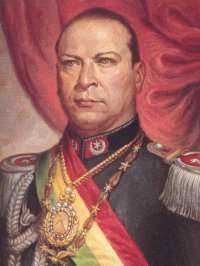Gualberto Villarroel
| Gualberto Villarroel | |
|---|---|
 | |
| 46th President of Bolivia | |
|
In office 20 December 1943 – 21 July 1946 | |
| Vice President |
None (1943-1945) Julián Montellano (1945-1946) |
| Preceded by | Enrique Peñaranda |
| Succeeded by | Néstor Guillén |
| Personal details | |
| Born |
Gualberto Villarroel López 15 December 1908 Cochabamba, Bolivia |
| Died |
21 July 1946 (aged 37) La Paz, Bolivia |
| Nationality | Bolivian |
| Political party | Non-party |
| Military service | |
| Allegiance |
|
| Service/branch |
|
| Battles/wars | Chaco War |
Gualberto Villarroel López (December 15, 1908 – July 21, 1946) was the head of state of Bolivia from December 20, 1943 to July 21, 1946. A reformist, sometimes compared with Argentina's Juan Domingo Perón, he is nonetheless remembered for his alleged fascist sympathies and for his violent demise on July 21, 1946.
Early life
Villarroel was born in Villa Rivero, Cochabamba Department, on December 15, 1908. He participated in the Chaco War (1932–35) against Paraguay. After Bolivia's disastrous defeat in that conflict, he became convinced that Bolivia needed profound structural changes and supported the progressive Military-Socialist dictatorships of David Toro Ruilova and Germán Busch (1936–39). Following Busch's suicide in August 1939, conservative forces reasserted themselves, took power, and won the 1940 elections in which the traditional (oligarchic) parties linked to the country's big mining interests (known as "La Rosca") triumphed at the polls with General Enrique Peñaranda. Villarroel was part of the younger, more idealistic military officer corps that had supported Toro and Busch.
Coup
After the December 1943 coup d'état, Villarroel became the de facto president. He formed a coalition with the main reformist party of the time, the Revolutionary Nationalist Movement, as well as with a now-open military faction known as Radepa (Razón de Patria, or Fatherland's Cause) inspired on the ideals of Busch.
Villarroel enacted a number of far-reaching reforms, including official recognition of worker unions, creation of a retirement pension and the abolition of obligatory unpaid servitude known as mit'a and pongueaje. He also followed Busch's lead in calling a National Assembly, instituting Constitutional reforms and having himself proclaimed Constitutional President by Congress in August 1944.
On the international front, Villarroel initially faced a formidable obstacle in US reluctance to recognize him as the legitimate President of Bolivia. The cause was the pro-Axis stance of the 1936–39 military regimes that inspired the Villarroel government and (it was alleged) some of his closest aides from the MNR party. Eventually, the Roosevelt administration extended its recognition after the expulsion from the cabinet of a number of "tainted" ministers first and the later break with the MNR.
Opposition
The conservative backlash against Villarroel did not take long to appear, fed by the considerable resources of the private mining interests. Moreover, the workers themselves decided to exercise their new rights to protest to demand further concessions in a manner that seemed imprudent and excessive, forcing the government to adopt repressive measures to maintain control. The extreme zeal of the government's repressive apparatus (weary of the chaos and the increasing momentum of the right-wing opposition) led it to commit a number of shocking acts, including the execution of various prominent members of the intelligentsia and subsequent disposal of their bodies by pushing them off a 3,000-foot (910 m) cliff. That gave the traditional parties the excuse to initiate a nationwide revolt that killed the president.
Overthrow and death
On July 21, 1946, anti-government crowds took control of the Plaza Murillo, the site of the Palace of Government (the so-called Palacio Quemado), laying siege to it. From within the Palace, Villarroel announced his resignation, but the enraged crowds of teachers, students, and marketplace women seized arms from the arsenal and broke in, after an hour of fighting, assassinating him and various of his aides.
Villarroel's body was tossed from a balcony into the square, where the crowds proceeded to hang it from a lamp-post opposite the Palace. They were perhaps inspired by a recent newsreel of Benito Mussolini's demise.[1]
The opposition regained control of the government, keeping it until the Bolivian National Revolution, in 1952.
References
Sources
- Céspedes, Augusto. El Presidente Colgado.
- Mesa José de; Gisbert, Teresa; and Carlos D. Mesa, 3rd edition. pp. 572–577.
| Political offices | ||
|---|---|---|
| Preceded by Enrique Peñaranda |
President of Bolivia 1943–1946 |
Succeeded by Néstor Guillén |